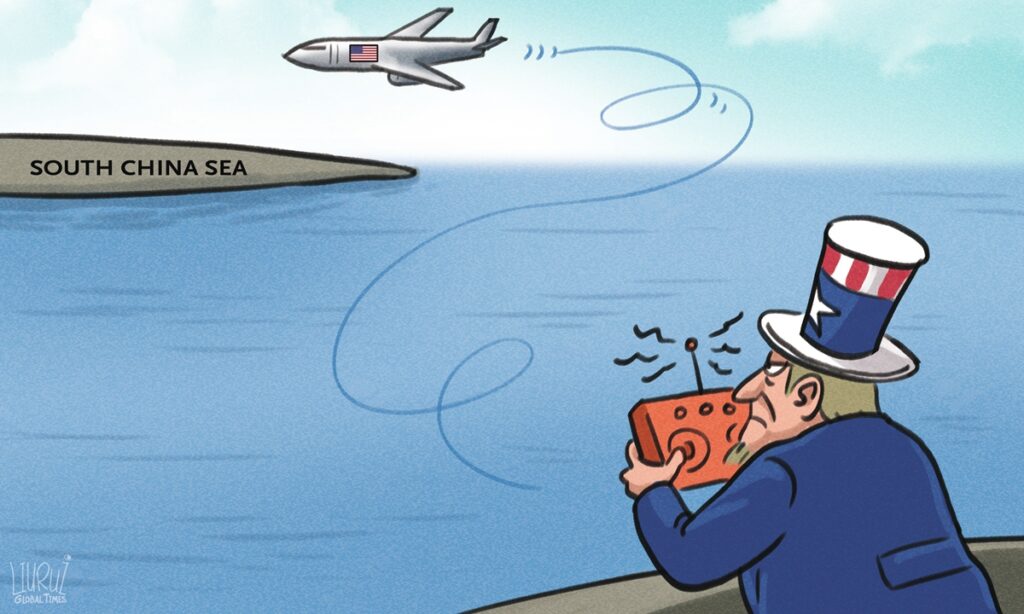The latest video released by the US military on October 26 of a Chinese fighter jet and a US bomber flying over the South China Sea “in danger of collision” has revealed the truth behind the US speculation over the so-called perilous intercept. According to the US Indo-Pacific Command, the 38-second video shows the Chinese Shenyang J-11 flying within 10 feet (3 meters) of the B-52 bomber on the night of October 24 in what it called an “unsafe and unprofessional manner.” The Indo-Pacific Command also said the Chinese pilot “demonstrated poor airmanship” and put “both aircraft in danger of collision.” Given that a few hours before the release of the US video, China had just released a video of the US military in the South China Sea approaching and disrupting normal training by the Chinese military, the US Indo-Pacific Command was probably furious, refuting and continuing to smear China.
In fact, the US’ false claims are not tenable at all. Anyone with even a little specialized knowledge will find that the PLA pilot’s nighttime interception demonstrated superb flying skills. Even more critical, but not mentioned by the US, is the fact that the US’ B-52 is a strategic bomber that can carry nuclear warheads, which is not the same as a usual bomber. Why did it appear in the South China Sea? What exactly did it do that would cause the Chinese side to make an emergency interception at night? Two B-52 strategic bombers intruded without authorization into the adjacent airspace of China’s Nansha Islands in 2015, and the Pentagon later made a special statement. The B-52’s appearance in the South China Sea has also received international attention many times since then. Not only did the US military take it for granted, but it accused the Chinese side of unjustified interception. It can be seen that with regards to the “dangerous encounter” caused by the US military’s close reconnaissance in China’s neighborhood, the US military’s real concern over the dangerous situation is much lower than its interest in hyping up the danger.
Even the US media also admitted that the US is now becoming increasingly open to releasing such videos. Starting this year, the US military announced a number of similar “dangerous encounters.” Not long ago, the US deliberately “declassified” more than 180 such incidents before the release of the 2023 China Military Power Report. The US is obsessed with this approach of achieving its triple goal, not only of playing up the “China threat” and tarnishing China’s image, but also of finding excuses for its so-called “close reconnaissance” and “freedom of navigation,” and then pressuring China to accept “crisis management” as defined by the US. It is worth noting that one consequence of this intense exaggeration and hype is that “dangerous encounters” seem to have become a common state of the current tensions, and this psychological and public numbness, in turn, increases the risk of friction and conflict.
A collision between China and the US has happened before. Over the past two decades, both sides have expressed the desire to avoid a recurrence of such tragedies. Considering that almost all “dangerous encounters” have occurred in the maritime and aerial areas around China, it can be said that China has been making efforts in “crisis management” all along. The reason why the frequency of “dangerous encounters” has been increasing in the past two years ultimately lies in the fact that the party responsible for creating the crisis has become more frequent in its actions. Under its strategy of containing China, the US does not genuinely want to avoid conflict but rather has a strong impulse to demonstrate its military power through provocative actions against China, as it seeks a psychological advantage over it and gives the world the impression that it can “restrain” China.
This is like drivers on the highway who frequently cut in front of others just to show off their driving skills. These reckless people are the real source of danger. In contrast, all of China’s actions are taken in legitimate self-defense. As the spokesperson for the Chinese Ministry of National Defense pointed out, the close encounters between Chinese and American ships and aircraft all occur in the maritime and aerial areas surrounding China, not in the Gulf of Mexico or off the coast of the US. It is the US side that comes to China’s doorstep to provoke and cause trouble. If you don’t come here, how could I stop you?
In recent times, with increased interactions between China and the US on various fronts, military exchanges and dialogues have also gained attention from all parties. This is one of the important factors behind the recent release of the video by the US. It is necessary to point out that from past to present, there have been numerous military exchanges between China and the US, particularly regarding encounters at sea or in the sky. The issue lies in the fact that in these exchanges, the US has consistently used the physical safety of its military planes and ships as leverage to force China to accept its provocative actions and threats to China’s national security. Communication between both sides should focus on substantive content. The key to effective military exchanges and dialogues between China and the US lies in full respect for each other’s security concerns, rather than sacrificing the security interests of one side to achieve the hegemony of the “absolute security” of the other. If this understanding is reached, it will be a natural and productive step to getting the two militaries’ relations back on track.




